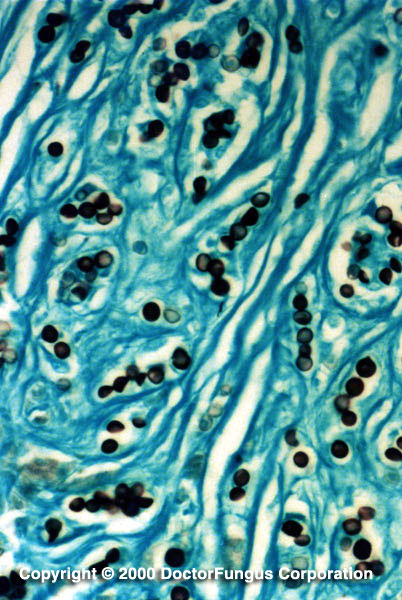Rixford et Gilchrist, 1896
Taxonomic Classification
Kingdom: Fungi
Phylum: Zygomycota
Subphylum: Zygomycotina
Order: Entomophthorales
Family: Uncertain
Genus: Lacazia
Description and Natural Habitats
Lacazia is a yeast-like fungus that causes infection in humans and bottle-nosed dolphins (Tursiops truncatus). Aqueous environment appears to be mandatory for the life cycle of Loboa. It is saprophytic in water and is transmitted to the vulnerable host via contact. Infections due to Lacazia are mostly reported from tropical zones [462, 997].
Species
The genus Lacazia contains a single species, Lacazia loboi. While the name Loboa loboi is still frequently used to refer to the causative agent of lobomycosis, more recently, classification of the fungus in the genus Lacazia and conclusively, the name Lacazia loboi has been proposed by McGinnis et al. [2213].
Synonyms
See the summary of synonyms and teleomorph-anamorph relations for the Lacazia spp.
Pathogenicity and Clinical Significance
Lacazia loboi is the causative agent of a tropical mycosis, lobomycosis, which is characterized by mucocutaneous lesions, that are usually nodular, vegetating, verrucose, cauliflower-like and hyper- or hypopigmented. Lower extremities and the ears are most commonly involved. Nasal and labial lesions have rarely been reported [347, 462, 1114, 1943, 1944].
Aquarium employees and farmers constitute most of the cases with lobomycosis. Occupations such as gold-mining, fishing, and hunting also predispose to Lacazia loboi infections. A previous cutaneous trauma, insect bite or wound cut enhance the entry of the fungus through the skin via contact with infected surrounding, such as dolphins. There is no evidence of person-to-person transmission of lobomycosis [462].
Macroscopic Features
Attempts to grow Lacazia loboi on artificial media have as yet been unsuccessful.
Microscopic Features
Numerous yeast-like, round, thick-walled cells are visualized. Chains of yeast cells are typically formed. Little tube-like connections are visible between the yeast cells [462].
Histopathologic Features
Granuloma and yeast-like cells (diameter: 5-12 µm) forming chains are observed. As well as tube-like connections between the cells, secondary buds may also be visualized. The cells may be phagocytosed by histiocytes or multinucleated giant cells. Periodic-Acid-Schiff (PAS), Gomori’s-Grocott’s and Gridley’s silver stains are used for examination of histopathological sections [462].
Compare to
Cross-antigenicity has been detected between Lacazia loboi and Paracoccidioides brasiliensis [365].
Susceptibility
Since efforts to cultivate Lacazia loboi have failed, no in vitro susceptibility data are available. Optional treatment of lobomycosis is surgical excision. Full excision of the lesion is required for clinical success. Repeated cryotherapy may also yield favorable clinical response. While there yet appears no optional medical therapy, clofazimine has been effective in some cases with lobomycosis [462, 1895].

